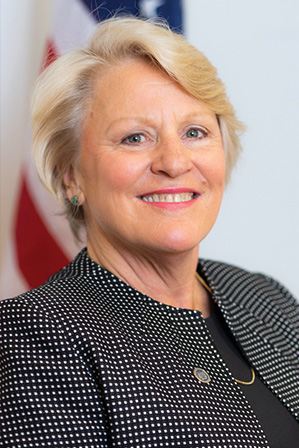The State of State: Putting the Back Channel Up Front
President’s Views
BY BARBARA STEPHENSON

I am so pleased that this edition of the FSJ contains an interview with Bill Burns. For those of you who have missed the voice of Ambassador Burns—I know I have—there is cause for celebration. His book is now finished—and at the top of The Washington Post’s nonfiction bestseller list, no less—and he is back in the public eye making the case for American diplomacy. AFSA was proud to host him on April 10 to talk about The Back Channel: A Memoir of American Diplomacy and the Case for Its Renewal.
The Back Channel is getting excellent reviews, and The Washington Post review by David Ignatius, who writes regularly on national security issues, is no exception. He finds much to admire in this “masterful diplomatic memoir,” but the line in the review that has most stuck with me, been hardest to shake, is Ignatius’ conclusion that the State Department is “gutted” and that, much as a reader wishes Burns were still in government, one “wonders if even he could make much of a difference.”
That is a sobering, even jarring assessment of an institution to which I have proudly and gladly devoted myself for more than three decades. So, what is the state of the State Department?
That is a topic retired members of the U.S. Foreign Service have been addressing all over the country as part of the Foreign Policy Association’s Great Decisions series, many of them drawing on background material and talking points provided by AFSA. We have given serious thought to “the state of State,” and I’d like to use this, one of my few remaining columns as AFSA president, to frame the issues facing our institution.
BY THE NUMBERS
- Three out of six under secretary positions are not filled; only three are (P, M and T).
- Nine out of 24 assistant secretary positions are not filled, including four of the six geographic bureaus (EAP, NEA, SCA, EUR); the latter two do not have a nominee.
- 28 ambassador positions are vacant and have no nominee, including Brazil, Chile, Cuba, Estonia, Georgia, Honduras, Jordan, Pakistan, Panama, Qatar, Singapore, Thailand and the United Nations.
- At least 20 additional ambassador positions are vacant, but a nominee has been announced; Egypt, El Salvador, Ireland, Libya, Mexico, Morocco, South Africa, Sweden, Turkey and the United Arab Emirates are among them.
- At USAID, only four of 11 Senate-confirmed appointees are in place.
- Only one career FSO is serving at the under secretary level (Hale/P) and one at the assistant secretary level (Perez/DGHR).
First, the good news. The hiring freeze kept in place by Secretary of State Rex Tillerson was lifted as soon as Secretary of State Mike Pompeo arrived, and new members of the Foreign Service are once again filling our ranks, with A-100 and specialist classes reporting for duty even during the government shutdown.
Strong bipartisan majorities in Congress have made clear they do not support weakening American diplomatic capability. Congress instructed the department in Fiscal Year 2018 appropriations to resume hiring; even stronger language in the FY 2019 appropriations prohibits the department and USAID from falling below specified staffing floors and encourages the department to hire above those numbers.
What is more, Sec. Pompeo stated in his March 27 testimony before the House Foreign Affairs Committee: “By the end of this year, we’ll have at or near more FSOs than ever in the history of the United States of America.”
Department workforce figures show State is well on its way to restoring FSO bench strength, particularly in the mid-ranks. There were more officers in each of the mid-ranks—FS-1, FS-2 and FS-3—in December 2018 than in December 2016.
The mid-level staffing deficit is now behind us, and the hiring freeze was lifted in time to preserve the health of State’s mid-ranks. This bodes well for the future of our institution, and it also sets us up to restore core diplomatic staffing at embassies right now.
That is, with our healthy mid-ranks and the $84 million plus-up for “overseas programs” contained in the FY 2019 appropriations, State is in a position to address the deficit in overseas positions identified by the Overseas Staffing Board and described in such vivid detail by FS members serving in understaffed embassies—especially those facing daunting competition from China and other rising powers.
As Sec. Pompeo said to HFAC, it is time “to get those folks out there so we can deliver American diplomacy in every corner of the world”—including in Africa, where American diplomats working on economic and commercial issues are regularly outnumbered by Chinese counterparts five to one.
If State’s mid-ranks are in such good shape, why does a well-respected writer like Ignatius describe State as “gutted”? The problem, of course, is at the top. State’s senior ranks are, by all accounts, seriously depleted.
The same workforce figures that provide such a reassuring picture of the health of our mid-ranks highlight the weakened leadership bench: from December 2016 to December 2018, the number of Career Ministers (three-star equivalents) fell from 33 to 19; Minister Counselors (two-star equivalents) fell from 470 to 376; and the number of Counselors (one-star equivalents) fell from 459 to 391.
In his interview, Bill Burns neatly draws the connection between senior vacancies and depleted ranks: “There are too many senior vacancies, and too few opportunities for career professionals.” As I explain to members of Congress, the media and the public when I talk about the state of State, these two issues—unprecedented senior vacancies and depleted senior ranks—are interconnected.
The best way to retain top talent, especially in a mission-driven organization like the U.S. Foreign Service, is to give that top talent a mission, to assign senior officers to senior positions. Leave highly talented officers on the sidelines for too long, and they will, reluctantly, decide that it is time to move on.
The vacancies are, as national attention to the issue suggests, an immediate problem: Vacant senior positions weaken State, the Foreign Service and embassies, and undermine operational effectiveness all around the world. And they also fuel the problem of depleted senior Foreign Service ranks at State, encouraging still more highly talented and deeply experienced officers to give up and depart, further weakening the corps.
Opportunities for career professionals are further squeezed by extraordinary numbers of political appointees filling senior positions. Only one assistant secretary position is currently filled by a career FSO, and only half of current ambassadors are drawn from the career Foreign Service, when the historical norm is closer to 70 percent.
So how do other leading diplomatic services deal with this challenge? They don’t!
Reporting on a comparative study of eight leading diplomatic services that AFSA sponsored to glean best practices, Jeremi Suri and Robert Hutchings observe: “In all eight countries, ambassadorial posts are almost entirely reserved for career diplomats. Most ambassadors to key posts have prior experience as ambassadors, speak the local language fluently and have served in senior levels in their home ministries.”
Suri and Hutchings conclude: “The United States is an extreme outlier in the number of political appointees who serve as ambassadors and senior leaders in the State Department.”
In addition to reducing opportunities for career diplomats, the extraordinary number of political appointees presents other challenges for “a career foreign service, characterized by excellence and professionalism,” which Congress mandated in the Foreign Service Act of 1980 as “essential in the national interest to assist the President and the Secretary of State in conducting the foreign affairs of the United States.”
Such a Foreign Service, I often say, must operate above the partisan fray. Yet Amb. Burns warns that “a particularly pernicious practice has surfaced, in which individual mid-level employees are blacklisted because they worked on controversial issues in the previous administration.”
This practice extends to the senior ranks and is yet another factor contributing to the depleted leadership bench. Career professionals who were particularly effective in achieving the foreign policy goals of the previous administration might also be, if given the chance, particularly effective at achieving a new administration’s foreign policy goals.
Sidelining effective career professionals is hardly a recipe for building a strong institution. What is more, the practice, Burns observes in response to a question about falling interest in the FSO test, contributes to “a pretty uninspiring recruitment campaign.”
As hard as it is to read that State is “gutted,” I remain grateful that national attention continues to be paid to the state of American diplomacy. Amb. Burns ends his interview by quoting de Tocqueville: “The greatness of America lies not in being more enlightened than any other nation, but rather in her ability to repair her faults.”
Like Burns, I wish our institution were not being so severely tested, but I would still bet on us to repair our faults and rebound.


